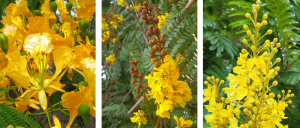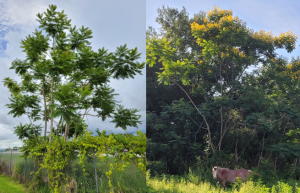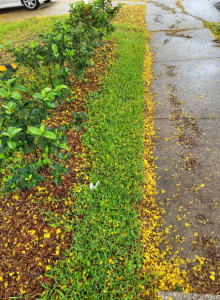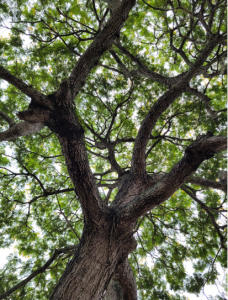Not that poinciana… and not that one either…

Throughout late Spring to mid-summer certain streets of the I-4 corridor are inhabited by hulking yellow figures that peer over buildings and walls throughout the urbanized landscape. Despite their enormity and vibrant nature, few know their name, origin, or really all that much at all about them. Upon closer inspection of these frozen fireworks displays, there is a deep green undercoat that suggests a leguminous origin. When the flowers fade, they are eventually replaced by brown wind-dispersed pods. That suspicion of being lumped in the bean (i.e., or legume) family would be correct… this is the South American yellow poinciana (Peltophorum dubium), another member of the Fabaceae family with an intense flowering capacity.

When most hear “poinciana” the orange to red royal poinciana (Delonix regia) typically comes to mind. There are some superficial similarities between the distant cousins (i.e., yellow poinciana and the royal poinciana trees), but they do not bear particularly close resemblance to one another to the trained eye as the royal poinciana tends to have more pairs of secondary leaflets (i.e., 25-35 pairs vs 8-20 pairs for yellow poinciana), buttressed roots, and an almost “extreme” vertically spreading form with a height maxing out at ~30 ft (i.e., compared to ~55 ft for the yellow poinciana). Flowers and pods are also quite different if they are present. There is one potential hang up, there is a yellow cultivar of the royal poinciana known as ‘flavida’ or ‘flava’ that has golden yellow flowers – however, the flowers are dark-golden yellow and the backside of the petals are “splashed” with white and red.


Natural and Cultural Histories
The South American yellow poinciana (Peltophorum dubium) is a native to Brazil, Argentina, Uruguay, and Paraguay – a world away from its cousin and doppelganger the Asiatic yellow poinciana (Peltophorum pterocarpum) that hails from the landmasses in the Western Indian Ocean. Some consider the South American yellow poinciana to be more slender and brittle relative to the other Peltophorum species (i.e. Peltophorum pterocarpum and Peltophorum africanum). Parts of South America where the yellow poinciana is native can be subject to relatively cold temperatures (at least by tropical to subtropical standards) which may have led to its greater cold hardiness relative to other Peltophorum species.

Known as cambuí, ibira-pita, or arbol de Artigas in its native range – this tree is heavily associated with José Artigas, a national hero of Uruguay, since the tree was present at his Paraguayan home throughout the final years of his life as an exile. Offshoots of these trees were then replanted to the city of his namesake in Artigas, Uruguay, where they are still found to this day.
The flowers are fragrant, with an aroma reminiscent of grapes. Bees are particularly drawn to the flowers. This tree is a pioneer species and is not exceptionally shade tolerant. Like many other early succession species, the seed pods are light and wind dispersed.

Quick Facts:
- Family: Fabaceae (i.e., the pea or bean family)
- Flowering time: Late spring to summer
- Height: 40-50 ft
- Spread: 30-50 ft
- Fruit: 2-4 in. thin, flat, winged pod that turns brown with maturity
- USDA hardiness zones: 9B-11
Considerations

Like many other trees within the legume family (i.e., cassias, mimosas, orchid trees, sennas, albizias, acacias, etc.), these trees are fast growers and can vault up to 30’ in the first 3 years of growth. There are pros and cons to fast growing trees. They can fill in a space and throw out a lot of shade in a relatively short interval. However, the yellow poinciana has relatively brittle wood. These trees tend to have shallow root systems and are not particularly resistant to strong wind or storms, so caution is recommended before planting them too close to structures or spaces heavily occupied by vehicles or people. Another potential concern is the tendency to sprout multiple stems. Cutting the tree back to a single stem while it is young will promote better structural integrity as the tree matures.

These trees have a high drought tolerance – a desirable trait for dry spells and the sandy soil conditions of Central Florida. The prolific flowers also translate to prolific seed abundance. The trees are well-suited to urban conditions and volunteer trees tend to appear in close proximity to established specimens. Although this species is not considered an invasive, some consideration against planting may be merited when adjacent to natural areas.

Yellow poincianas tend to flower annually but will sometimes not flower the following year when the tree has retained the pods from the previous season. Like other heavily flowering tree monsters that shed their seasonal coats, debris can also be an issue. The flower remnants are relatively light in weight but can be abundant throughout the early summer. This may limit the usefulness of the tree where the maintenance of a clean landscape appearance is a high concern.

Other Resources:
- Wikipedia page on Peltophorum dubium
- A close relative – Asiatic yellow poinciana (Peltophorum pterocarpum)
- Peltophorum dubium vs. Peltophorum pterocarpum by Edison and Ford Winter Estates
- Peltophorum dubium vs. Peltophorum pterocarpum (Florida Plant Atlas)
- Peltophorum dubium vs. Peltophorum pterocarpum (Kew Botanical Gardens)
- Tropical & Subtropical Trees: An Encyclopedia (Barwick, 2004)
 4
4
